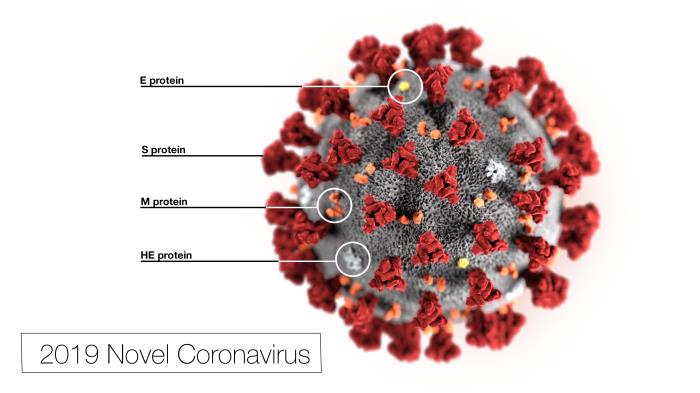
30 Jan Clinical Features of Patients Infected with 2019 Coronavirus in Wuhan, China
MedicalResearch.com Interview with:
Bin Cao, MD, PhD
Professor, China-Japan Friendship Hospital
Department of Pulmonary and Critical Care Medicine
Beijing 100029, China
MedicalResearch.com: What is the background for this study?
Response: In December, 2019, recent cluster of pneumonia cases in Wuhan, China, was caused by a novel betacoronavirus, the 2019 novel coronavirus (2019-nCoV). We report the epidemiological, clinical, laboratory, and radiological characteristics and treatment and clinical outcomes of the first 41 patients with laboratory-confirmed 2019-nCoV infection by Jan 2, 2020.

This illustration, created at the Centers for Disease Control and Prevention (CDC), reveals ultrastructural morphology exhibited by the 2019 Novel Coronavirus (2019-nCoV). Note the spikes that adorn the outer surface of the virus, which impart the look of a corona surrounding the virion, when viewed electron microscopically. In this view, the protein particles E, S, M, and HE, also located on the outer surface of the particle, have all been labeled as well. This virus was identified as the cause of an outbreak of respiratory illness first detected in Wuhan, China.
MedicalResearch.com: What are the main findings? How does this virus differ from other epidemics ie SARS or MERS or Influenza?
Response: The first 41 patients infected with 2019-nCoV as of Jan 2, 2020 had serious pneumonia, with high mortality rate at this stage because six (15%) of 41 patients died by Jan 22, 2020. Most of the infected patients were men; less than half had underlying diseases (13 [32%]), including diabetes (eight [20%]), hypertension (six [15%]), and cardiovascular disease (six [15%]). Median age was 49·0 years. 27 (66%) of 41 patients had been exposed to Huanan seafood market.
Clinical presentations greatly resemble SARS-CoV. Common symptoms at onset of illness were fever (40 [98%] of 41 patients), cough (31 [76%]), and myalgia or fatigue (18 [44%]); less common symptoms were sputum production (11 [28%] of 39), headache (three [8%] of 38), haemoptysis (two [5%] of 39), and diarrhoea (one [3%] of 38). Dyspnoea developed in 22 (55%) of 40 patients (median time from illness onset to dyspnoea 8·0 days [IQR 5·0–13·0]). 26 (63%) of 41 patients had lymphopenia.
Patients with severe illness developed acute respiratory distress syndrome (ARDS) and required ICU admission and oxygen therapy. The time between hospital admission and ARDS was as short as 2 days. Compared with non-ICU patients, ICU patients had higher plasma levels of IL2, IL7, IL10, GSCF, IP10, MCP1, MIP1A, and TNFα.
MedicalResearch.com: What should readers take away from your report?
Response: 2019-nCoV caused clusters of fatal pneumonia with clinical presentation greatly resembling SARS-CoV. Patients infected with 2019-nCoV might develop ARDS, have a high likelihood of admission to intensive care, and might die. The cytokine storm may be associated with disease severity.
MedicalResearch.com: What recommendations do you have for future research as a result of this work?
Response: More efforts should be made to know the whole spectrum and pathophysiology of the new disease. As of Jan 30, 2020 (11 AM Beijing time), 7,736 cases were confirmed to be infected by 2019-nCoV, with 170 died. The mortality rate was lower than that of the first 41 cases reported in our study, which is consistent with our speculation as more attention was paid to more severe patients at early stage.
As 2019-nCoV is an emerging virus, an effective treatment has not been developed for disease resulting from this virus. Future animal and clinical studies should focus on treatment of 2019-nCoV infection including antivirals, monoclonal and polyclonal neutralizing antibody products, and vaccines.
No disclosures
Citation:
Huang C, Wang Y, Li X, Ren L, Zhao J, Hu Y, et al. Clinical features of patients infected with 2019 novel coronavirus in Wuhan, China. Lancet. Published online January 24, 2020.
https://www.thelancet.com/journals/lancet/article/PIIS0140-6736(20)30183-5/fulltext
JOIN OUR EMAIL LIST
[mailpoet_form id="5"]We respect your privacy and will never share your details.
Last Modified: [last-modified]
The information on MedicalResearch.com is provided for educational purposes only, and is in no way intended to diagnose, cure, or treat any medical or other condition. Always seek the advice of your physician or other qualified health and ask your doctor any questions you may have regarding a medical condition. In addition to all other limitations and disclaimers in this agreement, service provider and its third party providers disclaim any liability or loss in connection with the content provided on this website.
Last Updated on January 30, 2020 by Marie Benz MD FAAD

